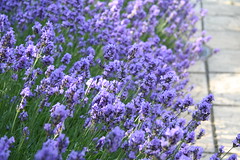|
|
| Three varieties of Eggplant (Photo credit: Wikipedia) |
|
|
| Italian Eggplants; Melanzane italiane; Italienische Auberginen (Photo credit: Wikipedia) |
|
|
| Thai eggplants at a market in Guam (Photo credit: Wikipedia) |
|
|
| Aubergines from http://www.usda.gov/oc/photo/98c0468.jpg (Photo credit: Wikipedia) |
Eggplant, aubergine, when I was little I knew them by their Hindi name - baigan. Whatever name you call them by, they're delicious.
Eggplants come in a wide array of sizes, shapes and colors from creamy white to shiny black, purple, red and even pink. It would be easy to grow a rainbow garden using nothing but different varieties of eggplant.
But to tell the truth,
eggplants are not that easy to grow. Honestly, they can be downright difficult.
If you happen to live in a warm,
humid area with long summers, you'll grow eggplant with ease.
For those that live elsewhere, let's just say you'll have to make some accomodations if you want to be successful.
South Dakota has the blazing summer temperatures that eggplants thrive in, but we lack the
humidity. I used to stubbornly try to grow eggplant every summer, only to end up with spindly, weak
fruits on plants that bolted.
I realized I had to give in and admit I couldn't meet the high water requirements needed to grow eggplant.
I did not give up though. After doing some research, I found that there are miniature varieties available that do not need nearly as much water as do the full-size fruits.
Mini eggplants only reach about three feet in height, making them perfect for small space, urban or container gardening.
Children love mini-eggplants too, not only because of their kid-friendly size but also because they are nearly seedless and have a skin so tender you don't need to peel them prior to cooking.
One of the most important things to successfully growing eggplants is
site selection. Choose a site that gets a lot of sun during the day, is sheltered from winds, and has deep, fertile, well-drained
soil.
Raised beds in sunny, sheltered locations are excellent for growing eggplant, provided that you mulch the bed deeply to retain moisture around the roots.
If you live in a less than ideal climate, you have a few options. Either grow eggplant in a greenhouse, in
raised beds under floating row covers for the first month, or in black pots (which hold heat better and will raise the temperature of the soil by as much as 10 degrees).
No matter which of these methods you choose, you'll want to start eggplant seeds indoors or buy starts from a nursery. Plant the starts or seedlings outdoors well after the last frost.
As an alternative (especially if you're growing in pots) set the plants outdoors during the day and bring the pots indoors during cooler nights. Eggplants need evenly warm soil in order to thrive.
If you've survived all of this and find yourself with a
plant full of baby eggplants, the next difficulty is figuring out when to harvest. Take note of the "days to harvest" listed on your seed packets, count the days out on a calendar and make a notation to start checking the fruits about a week prior.
Harvest too early or too late and the fruit will taste bitter. Generally speaking,the fruits are ready when they reach 4-5 inches in length. If your fruits start looking dull, they're overripe and will taste bitter and be full of seeds.
Eggplants are best eaten fresh, although they can be pickled. If you want to move past eggplant parmesan, try baba ganoush (a delicious eggplant dip), grilled eggplant, or eggplant lightly sauteed with extra virgin olive oil and basil clipped fresh from your garden.
And enjoy! You've earned it.
Have you ever tried growing eggplant?















































